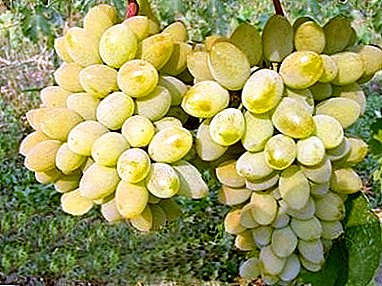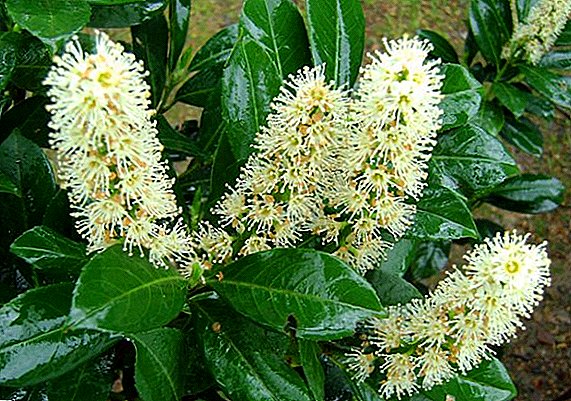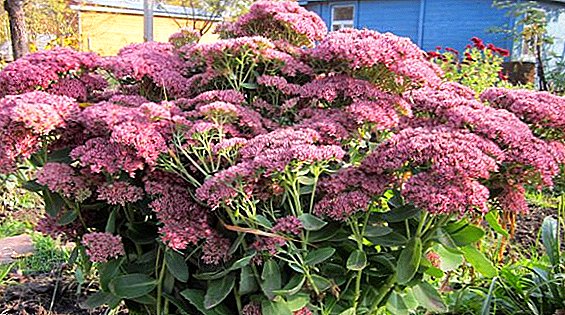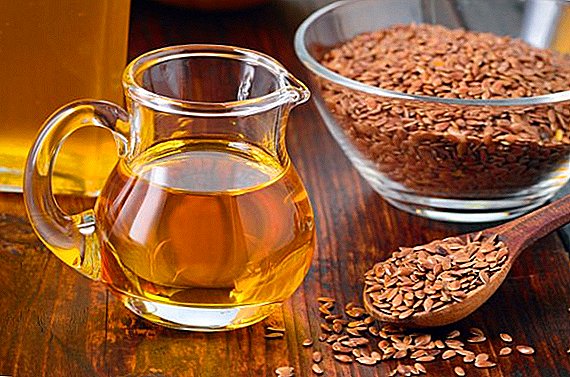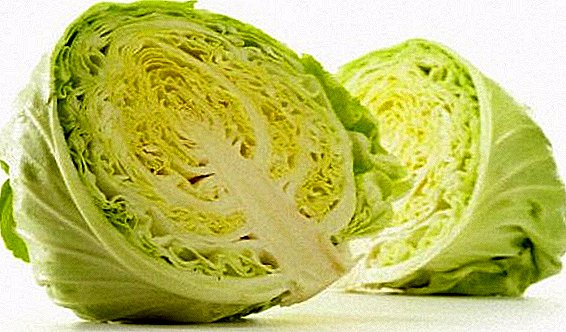
In a flower like Wanda, it is simply impossible not to fall in love. It attracts the attention of absolutely everyone who is related to orchids and not only. However, many people think that having such plants at home is easy and simple, which is very far from the truth.
Next, you will learn about planting and growing this flower, about caring for it at home, as well as how it looks in the photo. You can also watch a useful video on this topic.
Type definition and botanical description
Evergreen Vanda Orchid has no distinct rest period., and therefore not so long ago this species began to land at home, but he immediately became fond of it, because it blooms several times a year, however, it requires care.
 Wanda - monopodial orchids. By their nature, they do not produce pseudobulbs, as they grow in height, and do not expand at the same time in width. The stem reaches a medium length, and the leaves, which grow old, just gradually die off.
Wanda - monopodial orchids. By their nature, they do not produce pseudobulbs, as they grow in height, and do not expand at the same time in width. The stem reaches a medium length, and the leaves, which grow old, just gradually die off.
Wanda has a cylindrical shaft, which is densely covered with cingulate or flaccid bright green leathery leaves. Roots aerial, greenish-gray, usually strongly developed. Inflorescences Wanda several floral and multi-colored. It all depends on the species, as well as on the plants separately. They can be either oblique or straight, axillary or cruciate.
Peduncles grow from the sinuses that are between the leaves. They usually carry from 2 to 15 colors. According to the rules, at the same time, the color can reach a maximum of 1 to 4 peduncles. This group of orchids is notable for the development of flowers - from the very beginning, flowers bloom, they are pale, and their size is quite small, but do not worry, in 2-3 days all flowers will become healthy and saturated color and become larger.
The size of the flowers is very different, for some species it can reach 15 cm in diameter. The range of colors is quite large: from purple and blue to yellow or red. They can also be pink, blue, brown or white. Flowers can be monochrome or colorful. As for the aroma, not all species have it, but, nevertheless, some of them have wonderful aromas, it all depends on the type.
We recommend to watch the video about the features of Wanda orchids:
History of
Wanda was officially registered in 1795 by Englishman William Jones., first described this orchid while traveling in Asia. Translated "Wanda" means "whisper of the wind", by the way, before its leaves were used for medicinal purposes from bronchitis.
What is the difference from other species?
In addition to its amazing exotic beauty, Wanda is distinguished from other orchids by the presence of long, powerful, intertwined hanging roots of a gray-green color. Their surface is a porous structure and is capable of absorbing moisture not only from grass and tree trunks, but also from the atmosphere.
Subsort
As for the question of which orchids are Wanda, you will find exactly what you like.
Blue

Orchid with a vertical stem and numerous roots. The plant itself can reach 1 meter in height. Dense leaves are arranged in two rows. The length of the stem is 50-60 cm, the brush is multicolored. Wanda Blue has large flowers, famous for their fragrance.Their average size is 10 cm in diameter. The color is lavender blue, which often has a darker mesh pattern.
White (Rhynchostylis coelestis white)

It is very popular because of its color. This species is characterized by its compactness, since it is not so large, its leaves take up to 35 cm "in scope". However, this look is completely unpretentious. Compared to other Vandas there is not much sun. At the end of the peduncle there is a brush of flowers, small in size, which compensate for this with their number (there are a lot of them) and also with the presence of a pleasant aroma.
We recommend to watch the video about the features of the appearance of the White Wanda orchid:
Sander (Vanda sanderiana)

This beautiful large orchid boasts long, flexible leaves up to 40 cm long. Flowers are located at the end of the stem, forming a direct inflorescence, the number of which usually reaches 10 pieces. The color of flowers is pink, and they have a white frame and a yellowish-red lip. Their size is 10-12 cm (diameter).
Valkovata

This is an epiphytic large orchid, which has a strongly branched long stem with numerous roots. The leaves of this species are wax, from which the name of the species actually looks. Their length is 15-20 cm, and the diameter is 0.5 cm. This Wanda is also characterized by a long peduncle, on which usually there are from 3 to 6 large flowers, their color is usually pink or red.
Bloom
When and how is it going?
There is no well-defined rest period for Wanda, and he can bloom all year round., especially in the spring and summer, because at that time it is a long bright day. On average, flowering lasts 6-8 weeks, but sometimes it can last up to three months. Wanda's flower is an amazing creation of nature, and if you see it once, you will want to see it again.
Before and after flowering
Observing all agrotechnical requirements for the care of flowers, you can expect that Wanda will bloom annually and even more than once. If you are concerned that Wanda does not bloom, it may not have enough light, or the difference between day and night temperatures is less than eight degrees, or you can feed the orchid with nitrogen.
When the Vanda orchid has bloomed, cut the peduncles and keep the roots in a less moist state.Soak the roots once a week in a container of warm water. Spraying on time also needs to be stopped. If you have such an opportunity, take out the Vanda in the garden, hang it on a tree or place it on a balcony, on the terrace where the conditions are suitable, and take care of it as before flowering. Fresh air will certainly benefit her.
What if the bud does not break?
How to make your Wanda bloom? If she does not want to bloom for a long time, it means that she does not like something, there may be little light or the temperature difference between day and night does not persist, there is only one way out, how to make this bloom - you need to provide Wende comfortable conditions, and she will thank you.
Step-by-step instructions for care and maintenance
 As mentioned, Wanda is a very fastidious plant.. Therefore, care for them requires knowledge, attention and little experience.
As mentioned, Wanda is a very fastidious plant.. Therefore, care for them requires knowledge, attention and little experience.
Step by step, we will tell you all the features of Vanda orchid care - which temperature is better to choose for these flowers, what kind of lighting best suits them, how to water the Wanda and how to make its bloom longer and longer. In which substrate and pot it is better to transplant.
Choosing a landing site
The best place to plant an orchid is Wanda, of course, this is a greenhouse or mini-greenhouse, but you can also plant this exotic orchid on a window in the apartment and provide care only where there is a lot of space.
Soil preparation and pot
If you decide to plant the plant in the substrate, then it should be very light and breathable., it may include:
- large pine bark;
- coarse sand;
- moss;
- perlite;
- charcoal.
Board: In general, you can do without the substrate - just hang a Vanda in a basket or in a special pot - like a sieve due to the large number of holes.
Temperature
It is enough that the temperature regime is within 25 degrees, if it is slightly higher, do not be afraid, the main thing is that at night it does not fall below 12 degrees. And you need to remember that Wanda does not tolerate drafts.
Humidity
The recommended humidity for this flower is 60-80%, and the moisture index should be slightly lower during the day than at night. To increase the level of humidity, it is forbidden to use the spraying of a room or placing a pot on a tray with wet expanded clay.
We recommend watching the video about the humidity of the air around the Vanda orchid:
Lighting
In winter it is best for Wanda to be at the south window.Naturally, there will not be enough natural light, so you need to arrange additional lighting, and in the summer you will need to prune it - protect it from burns or rearrange it to the west window.
Watering
 In autumn and winter, water should be watered once a week (if the days are sunny) or once every ten days (on cloudy days). In the summer, water is watered about once every 3-4 days, soaking the roots in the bath (20 minutes) or under a warm shower.
In autumn and winter, water should be watered once a week (if the days are sunny) or once every ten days (on cloudy days). In the summer, water is watered about once every 3-4 days, soaking the roots in the bath (20 minutes) or under a warm shower.
All water procedures should be performed only in the morning, and the orchid should be dried in the bathroom, it should be placed in its place without any traces of water. Water for watering orchids should be at room temperature.
Top dressing
Wanda requires a lot of nutrients.. Therefore, it is necessary to feed it once a week with mineral fertilizer (only for orchids).
Transfer
Before transplanting an orchid, you need to carefully inspect the root system and remove its rotten parts. A transplant is performed when many new roots appear, and the container in which it is located becomes too small.
Breeding
Wanda, despite all its exoticism, you can also try to propagate at home. Over time, roots appear in the leaf axils of these orchids, it will be necessary to divide the bush - cut the upper part together with the roots. Immediately treat with charcoal cut place, let dry a little and put it in a special substrate for orchids.
You need to take care very carefully, you can only water from the sprayer once a week, and the normal irrigation regime is introduced only when our plant begins to grow.
We recommend to watch the video about the reproduction of the Vanda orchid:
Diseases and pests
Most often, Wanda is infected with Fusarium. It is a fungal disease, the infection of which occurs when the roots and leaves are damaged.
 In the active phase, the disease enters in the event of improper care, especially with watering, in which the green part of the orchid is exposed to moisture, as well as poor light. The most vulnerable plants in autumn and winter with low temperatures and lack of light.
In the active phase, the disease enters in the event of improper care, especially with watering, in which the green part of the orchid is exposed to moisture, as well as poor light. The most vulnerable plants in autumn and winter with low temperatures and lack of light.
For prevention, it is necessary to remove dry, badly damaged and darkened roots., badly damaged leaves. If a cut appears on the green part of the plant, sprinkle it with crushed coal and treat it with greens.
Important: If the leaves began to turn yellow and brown at the base and fall off one by one, the plant became sick. At the same time, the damaged part of the stem should be immediately removed, the incision should be made 6-7 cm above the upper affected leaf.
You can try to save the crown with the rest of the stem if it is capable of forming roots, i.e. the lower part of the stem above the cut is already sufficiently developed and strengthened. The cut is sprinkled with coal, treated with green and fungicides and protect against wetting.
Conclusion
Orchids are now incredibly popular and in demand, everyone loves them! Designers constantly use them in floral decoration, flower growers gradually bring out the most exotic species and are looking for new forms, manufacturers work tirelessly, constantly creating new hybrids. Orchids perfectly decorate and color our whole life, and not just our apartments. Now you know all about these colors!



